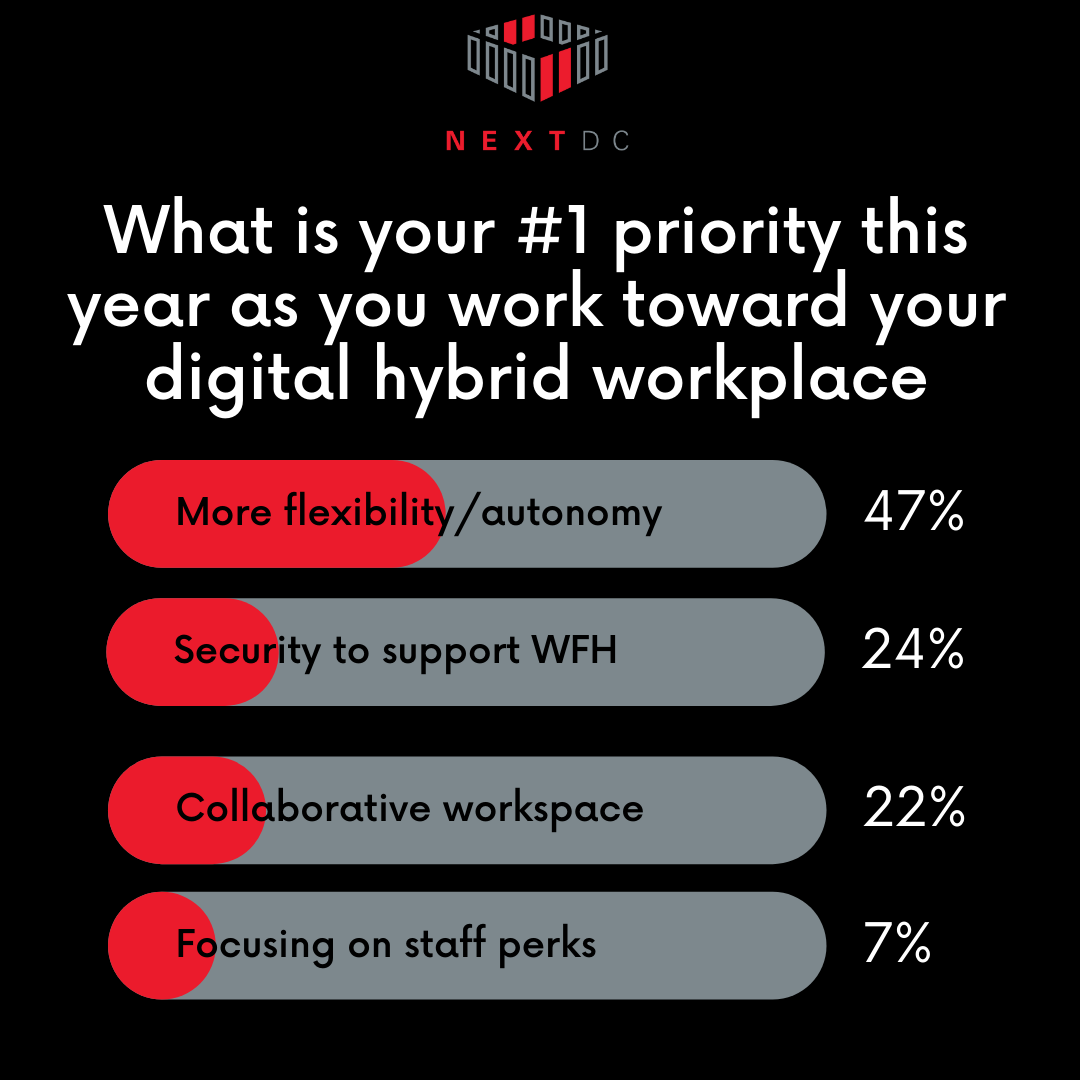By Adam Gardner, Head of Products
Flexibility has emerged as a key theme in the conversations we’re having with our customers about the hybrid digital workplace of the future. In fact, our recent poll found that greater flexibility and autonomy are the top priority for organisations as they plan for their workplace of the future:

Flexibility and autonomy - what’s the difference?
Flexibility means different things to different people: for some, it’s as simple as being allowed to work from home one or two days a week. For others, it’s having the freedom to get their work done from whatever location they feel best suits them.
While autonomy and flexibility are often used interchangeably, the difference between the two is subtle, but important. Autonomy means giving someone the freedom to make an informed decision about what works best for them.
So rather than saying “I am giving you permission to work from home two days per week”, you might say “I am giving you the autonomy to set your desired working schedule, as long as the work is done”.
There has been a lot of research into the role of autonomy in human behaviour, which has demonstrated a strong link to motivation, performance and wellbeing.
You can’t mandate autonomy, so throw away the rule book
It’s natural for business and people leaders to fall back on the policies and procedures that need to be written, consulted on and implemented in order to support any sort of widespread workplace change. This includes the shift towards more flexible work practices.
However, when you think about it, policies and procedures are, by their very nature, mandated from the top - so doesn’t that actually make them the complete antithesis of autonomy, which is all about empowering people making their own decisions?
One of the largest tech companies globally learned this lesson the hard way when they tried to mandate the company’s flexible work policy for corporate staff, by way of an all staff memo in June last year, after more than a year of COVID-era remote working practices.
This did not go down well with many of the organisation’s employees. Some chose to leave the company for greener, more autonomous pastures. Others joined a public campaign to raise awareness of the policy, pushing for the company to leave remote working decisions up to individual teams. This is the very definition of autonomy.
Based on the response to this experience, it smarter approach might be to move away from a detailed ‘flexible work’ policy in favour of introducing high-level, general principles and guidelines. In this scenario, line managers are likely to need more fulsome support and coaching, as they learn how to work with team members to develop work practices that suit everyone involved.
In short: you may be able to mandate or shape policies for flexible work practices but guidelines and communicating the intent will allow true autonomy.
Stepping up your focus on the ‘digital first’ mindset
The need for organisations to cultivate a ‘digital first’ mindset is gathering momentum, and the need for organisations to provide an environment where people are empowered to do the work that’s needed, from anywhere, at any time. It’s a fundamental building block to help achieve employee flexibility and autonomy.
We see an increasing number of our customers pursuing a hybrid digital workplace strategy, underpinned by the principles of hybrid IT - that is, the efficient allocation of IT resources and enabling capabilities where and when they are needed.
Read more: Reimagining the office: the role of ‘digital first’ in the race to a hybrid workplace
Just as there’s no right or wrong way to ‘do’ hybrid work, there’s no right or wrong mix of tools and technologies that need to exist in the workplace of the future. It’s up to the leaders of each organisation to build that picture based on their individual needs, priorities and circumstances.
At the end of the day, all that really matters is that employees have what they need to be efficient and autonomous, from wherever they choose to work.
Our experience is in helping organisations to separate their IT infrastructure and hardware from the humans that rely on it. This allows a greater focus on creating custom spaces and environments best suited to each, which is positioned the most sustainable and flexible locations with the lowest total cost of operation and the ability to adapt to the evolving needs of businesses and their people.
These hybrid by nature environments enable fluidity, so you aren’t wed long-term to specific tools and technologies. This environmental shift embodies a ‘right tool for the right use’ outlook which enables the right people, process and technology decisions as they’re needed, without causing disruption to operations. The underlying advantage and upside of a truly hybrid digital workplace is autonomy; where all resources - be it a human or technology resource – are empowered to act in accordance with what works best for them and the outcome being pursued.
Where to from here?
Flexibility and autonomy for your people may be the clear goal, but perhaps you need some help to plot out your roadmap between today and tomorrow.
It’s a privilege to work in partnership with many leading organisations to help them transition to their hybrid digital workplace of tomorrow. Reach out to NEXTDC to start the conversation and find out how we can help with your transformation.


